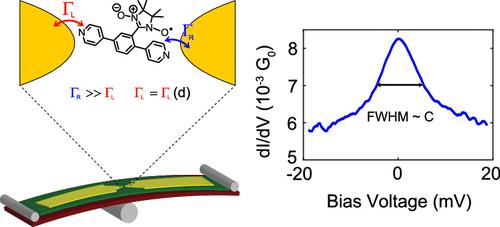有机自由基分子结中的机械稳定近藤共振
IF 3.2
3区 化学
Q2 CHEMISTRY, PHYSICAL
引用次数: 0
摘要
有机自由基由于其固有磁矩、低自旋轨道耦合和弱超精细相互作用而成为分子自旋电子学的有希望的候选者。在室温和低温(6 K)下,采用机械控制的断结装置,我们分析了两个硝基氮氧化物自由基(NNR)之间电荷输运的差异:一个在副构型中具有主干,另一个在元构型中具有主干。我们发现para-NNR在6 K时表现出近藤共振,而meta-NNR则没有。此外,在微分电导中观察到的近藤峰具有与电导无关的大致恒定的宽度,这与分子与电极不对称耦合的情况一致。本文章由计算机程序翻译,如有差异,请以英文原文为准。

Mechanically Stable Kondo Resonance in an Organic Radical Molecular Junction
Organic radicals are promising candidates for molecular spintronics due to their intrinsic magnetic moment, their low spin–orbit coupling, and their weak hyperfine interactions. Using a mechanically controlled break junction setup at both room and low temperatures (6 K), we analyze the difference in charge transport between two nitronyl nitroxide radicals (NNR): one with a backbone in the para configuration, the other with a backbone in the meta configuration. We find that para-NNR displays a Kondo resonance at 6 K, while meta-NNR does not. Additionally, the observed Kondo peak in the differential conductance has a roughly constant width independent of the conductance, consistent with a scenario where the molecule is coupled asymmetrically to the electrodes.
求助全文
通过发布文献求助,成功后即可免费获取论文全文。
去求助
来源期刊

The Journal of Physical Chemistry C
化学-材料科学:综合
CiteScore
6.50
自引率
8.10%
发文量
2047
审稿时长
1.8 months
期刊介绍:
The Journal of Physical Chemistry A/B/C is devoted to reporting new and original experimental and theoretical basic research of interest to physical chemists, biophysical chemists, and chemical physicists.
 求助内容:
求助内容: 应助结果提醒方式:
应助结果提醒方式:


